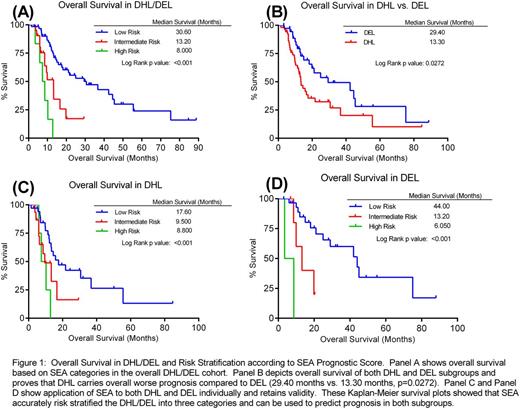Abstract
Background: MYC positive double hit lymphomas (DHL) (presence of c-myc and BCL2 or BCL6 rearrangements by florescence in situ hybridization (FISH) analysis) and double protein expressor lymphomas (DEL) (protein expression by immunohistochemistry (IHC)) represent a subset of diffuse large B cell lymphomas (DLBCL) with poor prognosis. Several prognostic scores systems have been applied such as the International Prognostic Index (IPI) and Revised IPI (R-IPI) but the most effective score remains to be elucidated. We explored the role of serum albumin (SA) in the prognosis of DHL/DEL as previously shown in de novo DLBCL (Dalia 2013) and developed a simple prognostic model that could predict clinical outcomes.
Methods: We included 91 patients from Moffitt Cancer Center from January 2008 to December 2015 diagnosed with DHL/DEL and performed a retrospective chart review after obtaining institutional review board (IRB) approval. Clinical data included SA, hemoglobin (Hb), age, IPI, treatment type, stage, bulky disease (>10 cm), extranodal involvement, cell of origin (COO) by Hans criteria, relapse and vital status. SPSS and Prism GraphPad were used to perform multivariate analysis (MV) and Kaplan-Meier (K-M) to evaluate statistical significance and survival outcome.
Results: Ninety-one patients (DHL= 53, DEL= 38) were included in the analysis. The median age was 63 years (18-87) with 36 (39.56%) females. There was stage III/IV disease in 80.22%, bulky disease in 48.35%, extranodal involvement in 39% of the patients and 15.38% patients had CNS involvement. With a median follow-up of 15.2 months, the median overall survival (OS) was 18.2 months (95%CI 11.9-24.5). MV analysis showed that SA ≤ 3.7g/dL (HR 3.85, 95% CI 1.67-8.81, p = 0.001), Eastern Cooperative Oncology Group (ECOG) performance status (PS) ≥2 (HR 2.28, 95% CI 1.00-5.16, p = 0.049) and Ann Arbor Stage III/IV (HR 2.58, 95% CI 1.19-5.62, p = 0.016) were statistically significant associated with poor OS. We devised the SEA score (Stage, ECOG and Albumin) as follows in 3 risk categories: low risk (LR):0-1 points, intermediate risk (IR): 2 points, high risk (HR): 3 points. K-M OS curves are shown in Figure 1. The median OS for LR, IR and HR were 30.6 (95% CI 13.2 - 48.1), 13.2 (95% CI 7.3-19.1), 7.4 (95% CI 4.2-10.6) months, respectively, p < 0.001.
We further explored the impact of SEA score separately in DHL and DEL subgroups. The median OS of DHL was significantly lower than DEL (29.40 vs. 13.30 months, respectively, p = 0.027, Figure 2A). SEA score was able to stratify both DEL and DHL subgroups accurately (Figure 2B and Figure 2C). DEL cohort had significantly greater OS compared to DHL in all risk groups (LR: 44.0 vs. 17.6 months, IR: 13.2 vs. 9.5 months, HR: 8.8 vs. 6.05 months; p< 0.001).
Conclusions: DHL/DEL is a heterogeneous disease with a poor OS in this study. We demonstrated that SA<3.7 g/dl is independently associated with poor OS. Hypoalbuminemia could represent a surrogate of comorbid status and worse biology in DHL/DEL patients. SA based prognostic system accurately identified three distinct risk categories. SA could be considered in the risk stratification of DHL/DEL.
Shah:Celgene: Honoraria, Membership on an entity's Board of Directors or advisory committees; Baxalta: Membership on an entity's Board of Directors or advisory committees; Incyte: Research Funding; Rosetta Genomics: Research Funding; Bayer: Honoraria; Pfizer: Honoraria. Bello:Seattle Genetics: Speakers Bureau; Gilead: Speakers Bureau. Locke:Kite: Membership on an entity's Board of Directors or advisory committees. Chavez:Janssen: Speakers Bureau.
Author notes
Asterisk with author names denotes non-ASH members.


